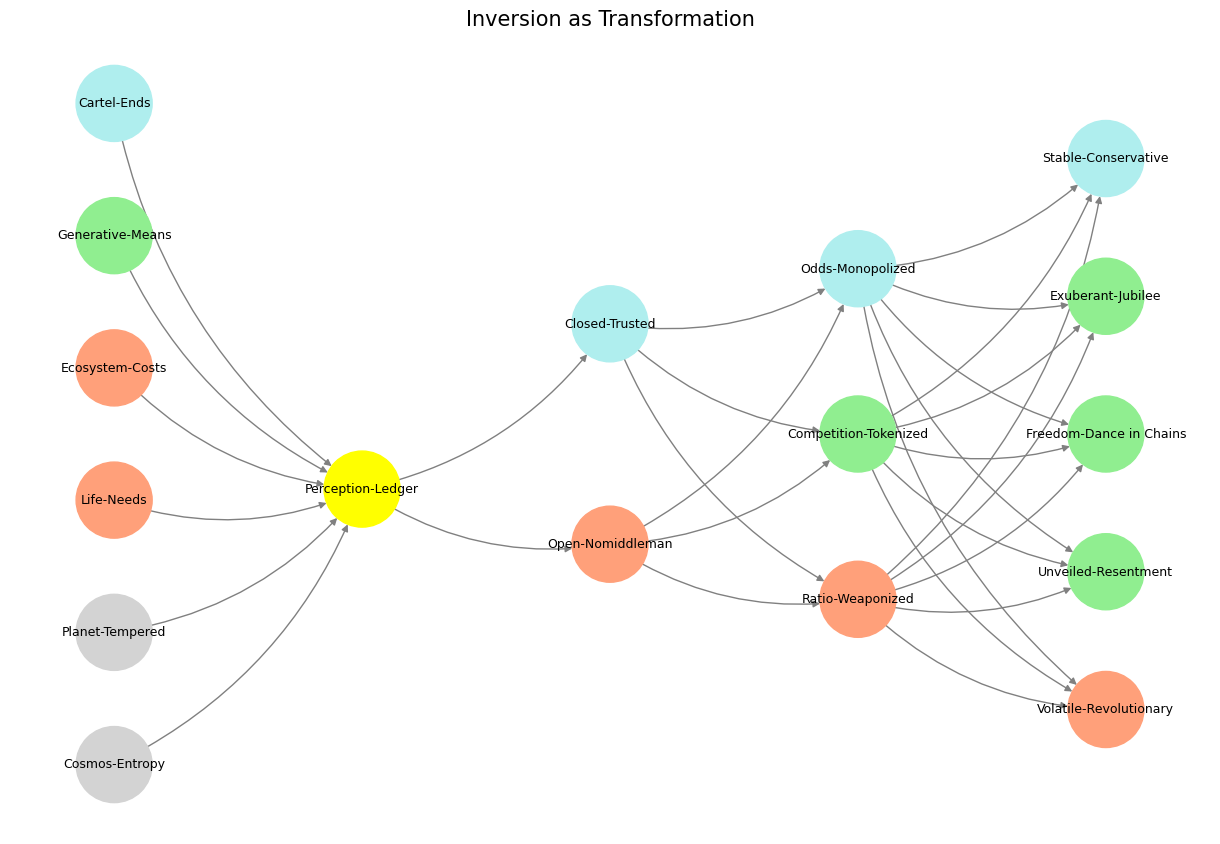Anchor ⚓️#
The opening chapter to The Various Flavors of Coffee evokes a sense of deliberate inversion—a conscious celebration of artifice, excess, and paradox, encapsulated by the epigrams and posturing described in the text. This celebration of the artificial over the natural, of Wildean aestheticism, aligns strongly with Nietzsche’s hammer—a tool for destruction, certainly, but also a means to rebuild in the wake of shattered idols.
From the perspective of your neural network framework, the metaphysical “inversion” here is fascinating. The first and fifth layers—world and physical—anchor the system in immutable reality and exertional agency, respectively. Yet, the inversion depicted in these images suggests a deliberate rejection of the physical and the immutable. Instead, it glorifies the intermediary layers: the metaphysical realm of cognition, ideas, and subjective aesthetic interpretation. Oscar Wilde’s aesthetic rebellion can thus be seen as an amplification of these cognitive layers, an insistence that artifice and the human mind’s capacity for self-created meaning transcend the immutable physical world.

Fig. 4 Strategic Ambiguity. The Red Queen presents rather fascinating scenarios to us.#
The inversion you describe—placing artifice, paradox, and excess above the natural or practical—is indeed an assault on conventional hierarchies. But unlike Nietzsche’s hammer, which demolishes idols with surgical precision, this aesthetic celebration operates indiscriminately, rejecting not just false idols but also the structures and constraints of reality itself. It’s not merely a reweighting within your network; it’s a reshaping of its core dynamics, privileging the subjective and cognitive layers over their physical foundations.
This aligns with the idea of the Red Queen Hypothesis in your framework. The pale nodes representing ecosystem dynamics—competitive adaptation and survival—are inverted here. Instead of the relentless, exertional interplay of survival, the text elevates a whimsical, non-survivalist mode of existence. It revels in the non-practical, the ornamental, rejecting the machinery of evolutionary necessity and embracing what might be termed a metaphysical decadence.
This decadence, however, is not nihilistic. It’s an expression of agency—a willful distortion of the physical and metaphysical laws to assert the primacy of art and imagination. If the laws of machines and tools represent humanity’s leveraging of means to ends, then the aesthetic rebellion described here rejects that utility. It asserts art as an end in itself, an affirmation of subjective meaning untethered from survival, productivity, or practical utility.
In the context of your neural network, this celebration of artifice could be seen as an emergent phenomenon—a temporary destabilization or even rejection of the equilibrium between the world and the physical. It’s a detour, a playful deviation that explores the potential of the cognitive layers to imagine and construct alternate realities. Yet, like any detour, it eventually circles back to the physical layer, which asserts itself as the foundation of all subsequent iterations. After all, even Wildean excess ultimately relies on the immutable laws of nature to sustain the bodies and minds that dream of such inversions.
This inversion thus highlights the tension between the physical and the metaphysical, between the immutable and the imaginative. It’s a Nietzschean experiment, yes—but one that revels in the temporary and the ornamental, affirming life not through existential will but through the joy of paradox and artifice. It is as though the cognitive layers, in their aesthetic excess, momentarily dominate the system, only to return to the grounding of the physical world in the next iteration.
Show code cell source
import numpy as np
import matplotlib.pyplot as plt
import networkx as nx
# Define the neural network fractal
def define_layers():
return {
'World': ['Cosmos-Entropy', 'Planet-Tempered', 'Life-Needs', 'Ecosystem-Costs', 'Generative-Means', 'Cartel-Ends', ], # Theomarchy, Mortals, Fire
'Perception': ['Perception-Ledger'], # God
'Agency': ['Open-Nomiddleman', 'Closed-Trusted'], # Evil & Good
'Generative': ['Ratio-Weaponized', 'Competition-Tokenized', 'Odds-Monopolized'], # Dynamics, Compromises
'Physical': ['Volatile-Revolutionary', 'Unveiled-Resentment', 'Freedom-Dance in Chains', 'Exuberant-Jubilee', 'Stable-Conservative'] # Values
}
# Assign colors to nodes
def assign_colors():
color_map = {
'yellow': ['Perception-Ledger'], # , Judgement Day, Key
'paleturquoise': ['Cartel-Ends', 'Closed-Trusted', 'Odds-Monopolized', 'Stable-Conservative'], # Slavery, Colonialism, Worker
'lightgreen': ['Generative-Means', 'Competition-Tokenized', 'Exuberant-Jubilee', 'Freedom-Dance in Chains', 'Unveiled-Resentment'], # Das Kapital, Frankenstein, AI
'lightsalmon': [
'Life-Needs', 'Ecosystem-Costs', 'Open-Nomiddleman', # Ecosystem = Red Queen = Prometheus = Sacrifice
'Ratio-Weaponized', 'Volatile-Revolutionary'
],
}
return {node: color for color, nodes in color_map.items() for node in nodes}
# Calculate positions for nodes
def calculate_positions(layer, x_offset):
y_positions = np.linspace(-len(layer) / 2, len(layer) / 2, len(layer))
return [(x_offset, y) for y in y_positions]
# Create and visualize the neural network graph
def visualize_nn():
layers = define_layers()
colors = assign_colors()
G = nx.DiGraph()
pos = {}
node_colors = []
# Add nodes and assign positions
for i, (layer_name, nodes) in enumerate(layers.items()):
positions = calculate_positions(nodes, x_offset=i * 2)
for node, position in zip(nodes, positions):
G.add_node(node, layer=layer_name)
pos[node] = position
node_colors.append(colors.get(node, 'lightgray')) # Default color fallback
# Add edges (automated for consecutive layers)
layer_names = list(layers.keys())
for i in range(len(layer_names) - 1):
source_layer, target_layer = layer_names[i], layer_names[i + 1]
for source in layers[source_layer]:
for target in layers[target_layer]:
G.add_edge(source, target)
# Draw the graph
plt.figure(figsize=(12, 8))
nx.draw(
G, pos, with_labels=True, node_color=node_colors, edge_color='gray',
node_size=3000, font_size=9, connectionstyle="arc3,rad=0.2"
)
plt.title("Inversion as Transformation", fontsize=15)
plt.show()
# Run the visualization
visualize_nn()


Fig. 5 How now, how now? What say the citizens? Now, by the holy mother of our Lord, The citizens are mum, say not a word.#

